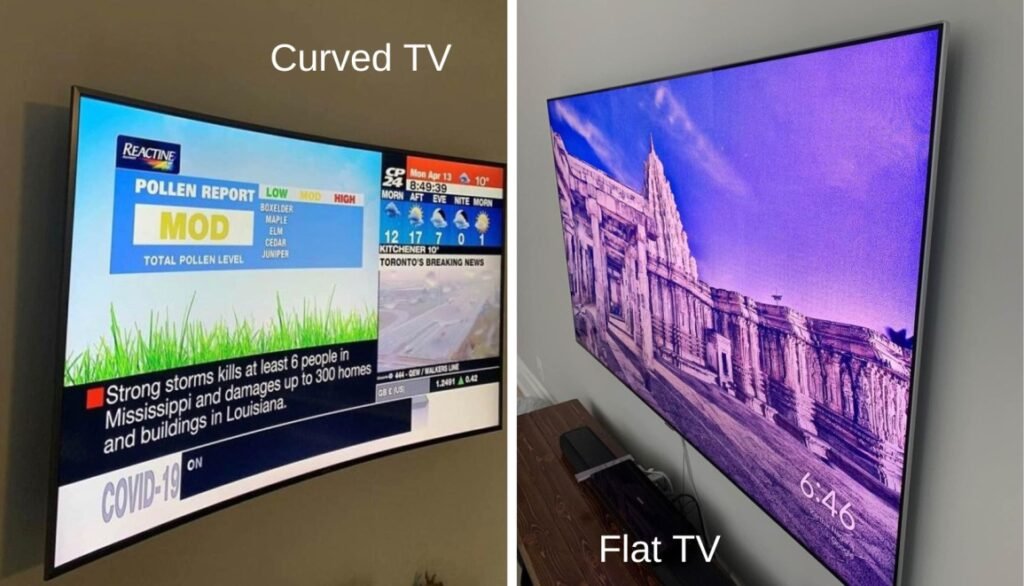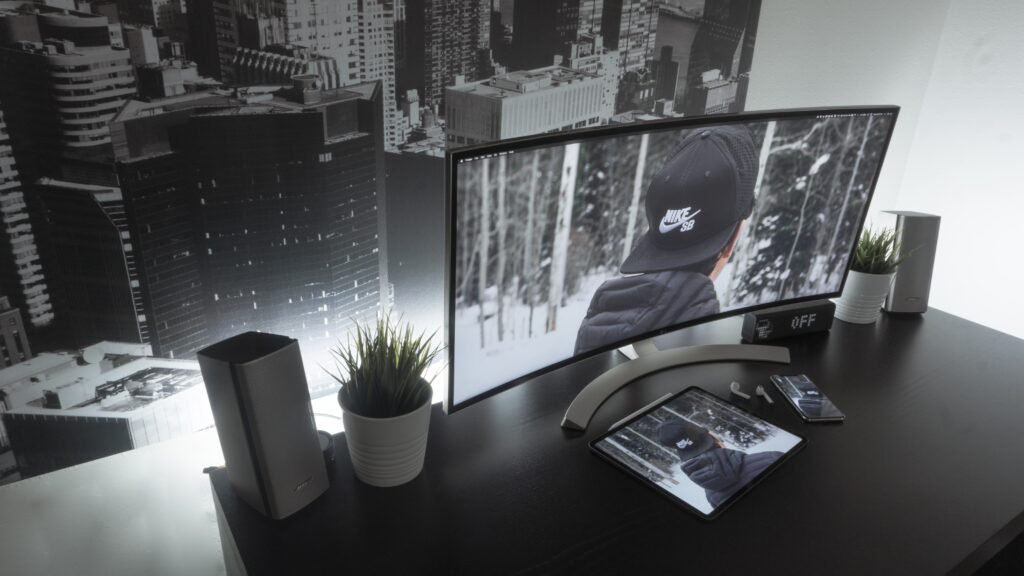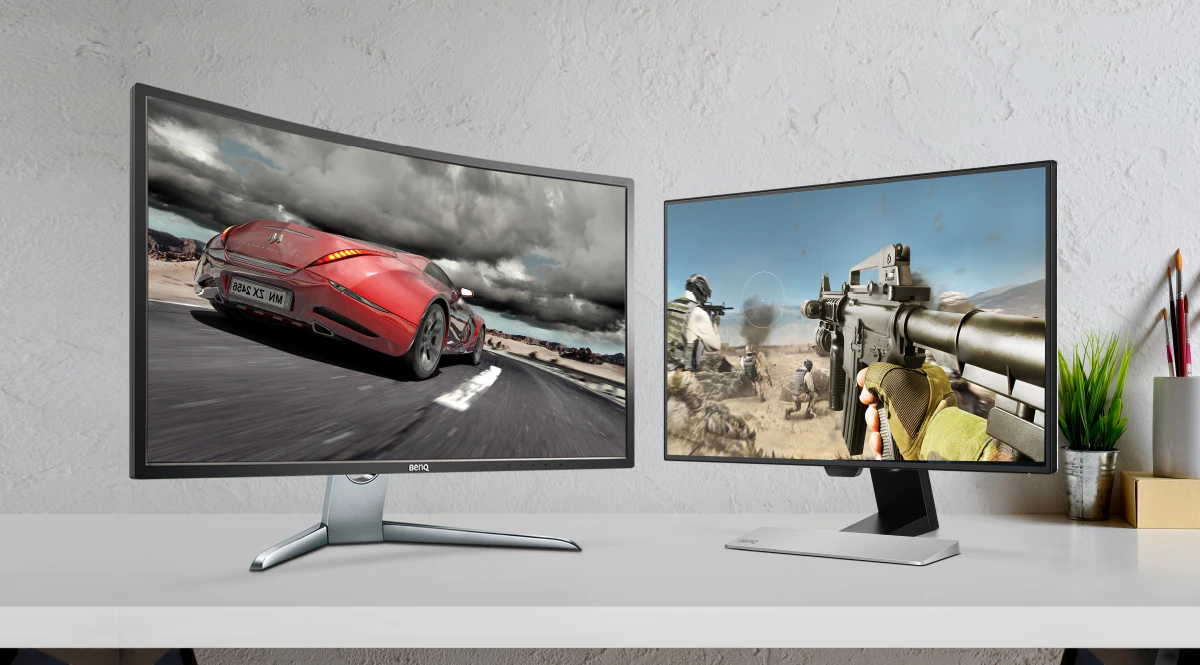The Curved vs. Flat TV debate is gaining more ground as users seek to understand what role tv screen shape plays in user experience. While there are no vast differences between both, there are simple distinctions that would come down to a matter of choice for each person.
Curved TV Vs. Flat TV

Questions about the extra features of a curved TV peaked after its launch and have remained a hot topic. This piece will compare Curved TVs vs. Flat TVs to give you the insight you need when choosing which to buy.
Viewing
When it comes right down to it, the nature of the human eye is not flat; instead, it is curved. Curved television gives the same experience as watching your favorite program from all angles of the eyes.
The pictures on the screen are curved, giving you the feeling of watching everyday events, making you feel more connected with what you are watching.
On the other hand, the Flat TV does not offer the same viewing experience. While we have become used to this over time, it does not necessarily mean that it is the best.
Picture Quality
Due to the shape of the Curved TV, the eyes naturally see better picture quality, especially around the edges – this means that images are often presented in much better quality than on the Flat TV.
Perhaps, this is why many commercial cinemas worldwide use more Curved TV screens to show snippets of movies currently playing.
Picture Depth
Due to the quality of pictures displayed on Curved TVs, they naturally feel like 3D images.

The curved screen displays the image on multiple depth planes – with a defined physical foreground and background, improving the overall viewing experience.
This picture depth is a vital feature that most producers like Samsung use a high-level processor to create images that perfectly fit curved screens, unlike Flat-screen TVs that mostly come in high definition.
Viewing Angles
Here, the images on the Curved TV can become distorted if viewed from certain angles.
People believe that viewing a curved screen from more than 30-35 degrees while watching makes the pictures look unnatural to the eye, making it a terrible viewing experience.

On the other hand, the Flat screen TV does not have this issue, as images on the screen are displayed correctly, provided you are facing the screen.
Viewing Position
As mentioned above, Curved TV can make for significant viewership. However, you have to sit in the “sweet spot,” which generally refers to an area just in front of the TV and close enough to it—trying to have a whole family sit and watch a curve tv might become a bit of an issue as some would not be in the right angles to view.
The Flat TV does not offer this predicament, as several people can sit at different angles facing the TV and still enjoy the images.

Light Reflection
For standard flat-screen television, any external light reflection will focus only on the screen’s part. You can readjust your blinds to fix this.
That is not the case with a Curved screen TV, as the light would go with the curve and distort images on the screen, which can be annoying sometimes. Any external light would make viewership frustrating on a Curved TV.
Cost
In the meantime, the cost of production for a Curved TV is higher than that of a Flat-screen TV. Naturally, this also makes it more expensive to buy. Hopefully, the price difference will normalize or get in the same range sometime in the future. However, that is not the case for now.
Shape
Over time, the world got used to Flat-screen TV, and the invention of Curved TV took the viewing experience to a higher level. Often, people stare in awe at the elegantly Curved TV, even when it is off. This has raised curiosity, and people are more inclined to buy them.
Curved TV Pros
There are other advantages of a Curved TV to a Flat-screen TV. Let’s take a look at some of them below:

Sleek Deigns
Simply put, the overall aesthetics of a Curved TV is mind-blowing. Perhaps we got so used to the Flat-screen TV that it seemed nothing could top that for a while. However, the sleekness we have seen with the Curved TV is entirely something that would continue to improve. The exterior design, size, and look of the Curved TV are pretty good.
Immersed viewing
Due to the curved nature of these screens, the general feeling is that you feel more in tune with the experience.
You do not have to strain your neck from one end of the TV to the other, as the shape is curved at the edges, making the necessary adjustments to meet your eyes.
Futuristic Image Quality
When watching images on a curved screen, the quality is much better than what you watch on most Flat-screen TVs.
A curved screen looks like one for the future. Many homes are still using Flat-screen TVs and are yet to fully embrace curved screens, making them look more impressive.
Like any new invention, it would take a little time for people to see the improvements and make better efforts to own Curved TVs. The high-end types also come in 4K picture quality, which is fantastic to watch.
Curved TV Cons
While significant, some elements of the Curved-screen TV are considered disadvantages. Most users hope that the TV companies will correct most of these cons for an even better viewing experience in time. Let’s look at some.
Cost of Purchase
Curved TVs don’t come cheap, and this is due to the overall cost of acquiring materials needed for production.
Furthermore, the demand for Curved TVs has not skyrocketed for now. However, there is some optimism that a higher demand globally would increase production and reduce the price in some quarters.
Position on The Wall
Curved TVs don’t look excellent when hung on walls, and this is due to the curve at the edges of the screen, which gives it an awkward look and makes viewership for more people a bit more complicated. So if you’re considering hanging your TV on a wall, definitely don’t buy a Curved TV!
Size Matters Afterall
To get the best viewing experience, the recommended size of a Curved TV is 55″ and above. The effectiveness of a Curved TV is proportional to its size, and you need to draw even closer and sit at specific angles to watch smaller-sized ones.
Flat TV Pros
Can be Viewed From Different Angles
Whether horizontally or vertically, Flat-screen TVs offer a much more balanced viewing experience. Since the surface is flat, many persons can sit comfortably around it and watch programs without issues.
Better Contrast with Light
If a ray of sunlight is peeking through the blinds; the reflection on a Flat-screen TV does not distort the pictures. You would immediately see where the light is coming from and where it reflects and close the light source. The picture quality would not go wrong because of a bit of sunlight.
Price Does not Affect quality
As we debate over Curved TV vs. Flat-screen TV, the price for Flat-screen TV is less than that of a Curved screen TV; sometimes significantly so. This does not mean that the picture quality and other features are inferior. The prices differ as expected, but there are some quality flat screen TVs on the market today that come in high definition and deliver impressive visuals.
Durability
Many flat-screen TVs are easier to mount on the wall, and if there is a need for repairs, this is done quickly. This ensures that one can use them for a while before any need for a change. On the other hand, the Curved TV is still gaining ground, and not many people possess the expertise to provide repairs when needed.
Flat TV Cons
Picture Quality Can Depreciate
With the invention of better screens, older ones naturally depreciate in image quality, as they are not adequately equipped to display modern images in high definition. However, you can fix this by upgrading to a better Flat-screen TV.
There are newer versions of the Flat-screen TV in 4K, which are seen as the holy grail in picture quality. If you need a Flat-screen TV of that quality, you can get it from the Amazon website for the best service and delivery. You can also buy from renowned producers like LG, Samsung, TCL, Vizio, Hisense, and Sony.
Size
While modern Flat-screen TVs come in much bigger dimensions, the earlier versions still in circulation are pretty smaller. The whole family might not be able to sit comfortably around a small screen tv, especially from different angles.
Design
The exterior design of some Flat-screen TVs often leaves a lot to be desired. Folks who prefer a sleek design to their TV would have to spend the cash needed to acquire the more modern ones, and these do not come cheap. On the other hand, Curved TVs generally come in better designs and are more pleasing to the eye.
Final Words
Both TV types have pros and cons from the above discourse. This is not the end of the debate on Curved TV vs. Flat TV, and it would generally come down to preference, budget, and what you need from a TV.

